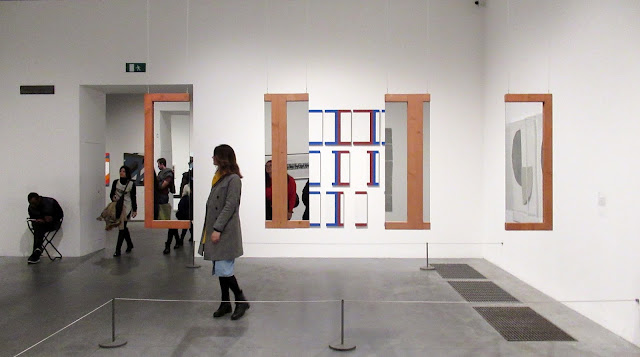Dora Maurer
at Tate Modern.
Seven Foldings, 1975, (drypoint on paper)
Seven Twists I-VI, 1979, (6 photographs, gelatin silver prints on paper)
Schautafel 4, (acrylic paint, ink, wood and graphite on board)
Working in Germany in 1972, Maurer made a series of Quantity Boards (using the German title Schautafel). Each one contained different quantities of natural materials, such as wood or straw, placed systematically into a grid. This work relates to the 'magic square', a mathematical game in which numbers are arranged so that they add up in every direction to reach the same total. Maurer uses painted twigs to represent the numbers, with different values assigned to different colours. The irregular form of the twigs contrasts with the ordered symmetry of the grid and the mathematical system.
Displacements, Step 18 with Two Random-Quasi-Images, 1976, (acrylic on canvas, wood)
Since early in her career, Maurer has been interested in the idea of 'displacement'. She associates the word with processes of movement, rearrangement and change. These concerns sometimes reflect the influence of music on her work, particularly the ways in which a composition can be developed through repeated variations on a theme.
4 out of 3, 1976, (wood, mirror)

This work plays with perception in a number of ways. The viewer shifts their perspective between two different geometric forms: the square and the rectangle. The mirrored surfaces also reflect the surrounding environment, adding another layer of dynamic movement and shifting perspectives.
5 out of 4, 1979, (acrylic paint on wood)
This painting consists of three rows of painted squares, divided into rectangular panels. The space between the panels changes in each row. In the first row, the gaps are equal. In the second row, Maurer uses her own mathematical pattern to establish the spaces. The gaps in the third row are based on the Fibonacci sequence, in which each successive number is obtained by adding together the two previous numbers, (0, 1, 1, 2, 3, 5, 8, 13, 21, 34, etc.) The work plays with perception as the viewer shifts their perspective between the painted squares and rectangular panels.
Relative Quasi Images, 1996, (5 paintings, acrylic paint on canvas, wood)
The five paintings comprising Relative Quasi Images are based on the same Quasi image, each very slightly shifted in its position on the canvas. The canvas above is painted according to Maurer's eight-colour system. However, the remaining canvases each deviated from this palette. These variations suggest our changing perception of colours under different light conditions at different times of the day.
In this group of paintings, made from 2007 to 2016, areas of bold colour seem to be layered on top of each other. Using perspective to create the illusion that some details are closer or further away, Maurer conveys the impression that the paintings have been projected onto curved surfaces. The colours float, taking on a life of their own.
Finally, in these two paintings, coloured shapes seem to move on the wall like figures dancing. The different colours and positions create a sense of rhythmic three-dimensional movement. Maurer describes this series as 'form gymnastics'.




































































